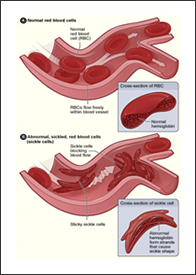SICKE CELL DISEASE
Sickle cell disease is a genetically inherited disorder that causes red blood cells to be sickle shaped instead of round. Due to their shape, these red blood cells tend to clot blood vessels including those of the retina. The blockage of retinal blood vessels through sickle cell clots can lead to vitreous hemorrhage and ischemia, both of which can seriously diminish eyesight.
Treatment of sickle cell disease symptoms involves diligently monitoring the patient’s ocular condition using OCT testing, fluorescein angiography, and/or microperimetry in order to employ preventative measures. While the prevention techniques of thermal laser and cryotherapy are not guaranteed to work, they can improve the patient’s visual condition by halting the progression of ischemia.
WHAT IS THE CONDITION?
Sickle cell disease is caused by a mutation in a gene called Hb SS. This gene leads to the development of abnormally
structured hemoglobin, which in turn causes red blood cells to be sickle-shaped. Only people who have inherited these genes will have sickle cell disease. Moreover, those with two of the sickle cell genes will experience symptoms of increased severity compared to those with one copy of the gene.
While the sickle shaped red blood cells can function, their shape leads to many complications including the greater risk of clotting. A clot occurs when the sickle shaped cells pile up against each other until they block the blood stream. This is a
serious complication that can cause blood vessels, including those of the retina, to burst.
The development of ocular complications begins with the bursting of retinal blood vessels due to a blood clot. When this occurs, blood pools into the vitreous body from the retinal vessel and blocks light from reaching the retina. This immediately causes the eyesight of the patient to diminish, but not permanently. Next, the persistent leakage of blood can give rise to ischemia, a condition in which retinal cells absorb the leaked blood until they are unable to dispose cell waste and uptake cell nutrients from the blood stream. As a result of ischemia, retinal vessels can not only die but stimulate the growth of abnormal choroidal neovascular membranes over the retina. Although the abnormal choroidal neovascular membranes are blood vessels meant to revive dying retinal cells, their fragility causes them to quickly break and bleed and thus worsen ocular ischemia and perpetuate retinal cell death. All in all, sickle cell disease can cause the severe loss of eyesight if not properly diagnosed and managed in time.

